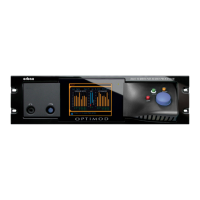OPTIMOD SURROUND PROCESSOR OPERATION
3-45
ALLPASS is a phase-rotating crossover that introduces one pole of phase rotation at
200 Hz. The overall frequency response remains smooth as the two bands take dif-
ferent amounts of gain reduction—the response is a smooth shelf without extra
peaks or dips around the crossover frequency. The two bands are down 3 dB at the
crossover frequency. However, this mode adds group delay distortion and is there-
fore subtly less transparent-sounding than the L
INEARNODELAY mode.
L
INEARNODELAY (Linear-Phase; no delay) is a phase-linear crossover whose upper
band is derived by subtracting its lower band from the crossover’s input. When the
upper and lower bands have the same gain, their sum is perfectly flat with no phase
rotation. However, when the upper and lower bands have different gains, peaks and
dips appear in the frequency response close to the crossover frequency.
LINEARNODELAY is useful if you need a crossover with low delay and no
phase distortion when flat. Its downside is the possibility of coloration
when the gains of the two bands are widely disparate.
LINEAR is a phase-linear crossover whose upper band is derived by subtracting its
lower band from the crossover’s input, as passed through a delay equal to the group
delay of the lowpass crossover filter. The overall frequency response remains smooth
as the two bands take different degrees of gain reduction—the response is a smooth
shelf without extra peaks or dips around the crossover frequency. The two bands are
each down 6 dB at the crossover frequency. This crossover has constant delay even
when the two bands have unequal gains.
While LINEAR has the ideal combination of no phase distortion (even
when non-flat) and smooth shelving behavior, it adds about 4 ms to the
overall delay (compared to A
LLPASS and LINODLY), so it is not a good
choice if you need to drive talent headphones.
AGC Controls Exclusive to 2.0 Processing:
AGC Matrix (2.0 processing only) allows you to operate the AGC in left/right mode
or in sum/difference mode. Usually you will operate in left/right mode. However,
sum/difference mode can give a type of stereo enhancement where the L–R signal is
allowed to have a higher gain than the L+R signal. This will only work if you allow
the two channels of the AGC to have different gains. To do this, set the AGC
MAX
DELTA GR control greater than zero.
The AGC in the surround processing is always stereo coupled. Its gain re-
duction is proportional to the r.m.s. sum of the channels.
AGC Max Delta GR (2.0 processing only) determines the maximum gain difference
permitted between the two channels of the AGC. Set it to “0” for perfect stereo
coupling.
This control works the same regardless of whether the AGC operates in
left/right or sum/difference M
ATRIX modes, in both cases controlling the
maximum gain difference between the “channels.” Depending on the
Matrix mode setting, the “channels” will handle left and right signals or
will handle sum and difference signals. When the AGC operates in

